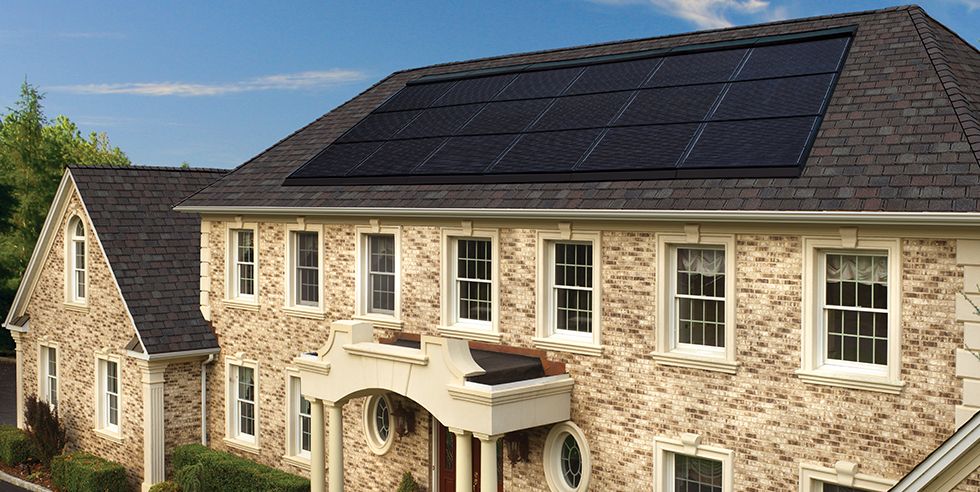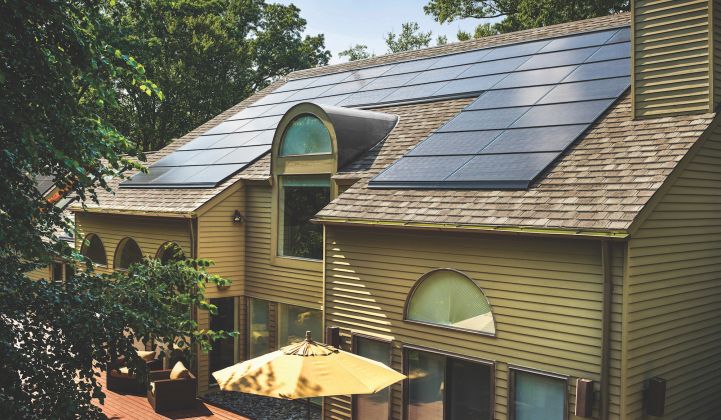When Elon Musk kicked off Tesla's solar roof product in October, he left several open questions about how Tesla planned to enter the roofing market itself.
Building a roof requires different expertise than putting solar modules on top of it. And the roofing industry has established distribution channels throughout the country, typically reaching customers via local contractors supplied by larger roofing distributors. Breaking into that world out of nowhere requires a bit of work.
There's another solar roof company that doesn't have to worry about that.
GAF claims the title of largest commercial and residential roofing manufacturer in North America. It's been around since 1886 and does billions of dollars in sales annually with a network of 5,000 certified contractors. And it's been investigating solar roof technology since the 1980s.
For GAF, the rooftop solar boom represented a possible market disruption for the old-fashioned roofing business, but one that could be additive rather than destructive. GAF redoubled its efforts starting around 2008, and after several rounds of refinement, launched the DecoTech product in January. Installations started in April.
The development process there offers a case study in how to merge best practices from the existing roofing industry into the new frontier of solar roofs.
The challenges of solar shingles
GAF makes a lot of roof shingles, but it dispatched with solar shingles in an earlier round of product development.
In that product architecture, every shingle needs a junction box to export power to the home. That becomes a fixed cost for each small unit of power production, making the economics less favorable than larger panels, said Tommy Rodrigues, the research scientist heading up the design effort.
Shingles also complicate the installation process with many more points of connection than a typical rooftop PV system.
The designers also experimented with CIGS thin-film technology, but dropped it as the supply chain started to vanish and crystalline silicon pushed ahead. Ultimately, GAF decided to utilize conventional 60-cell PV modules.
"If you're going to get to the lowest-cost product possible, it's not going to be from us making a very bespoke series of pieces," said Tony Ruffine, vice president of renewable energy, sustainability and strategic marketing. "You have to buy panels that are the same size as...[are made] every day, because there's a huge infrastructure around that."

(Image credit: GAF)
Installation involves stripping off the old roofing material, inserting the modules into a proprietary interlocking frame, attaching that in the center of the roof and filling around it with normal shingles. The UL-certified process makes the whole thing watertight, so rain passes over the system without seeping inside, much like it would over a skylight.
The resulting solar modules stand out more than a Tesla photovoltaic slate system, but they blend in better than a conventional rack-mounted PV approach. The PV frames interlock like roof tiles, but bigger and packing a higher power capacity.
"It's the idea of a shingle, but better economics," Rodrigues said.
The use of the common module form factor allows flexibility in sourcing, rather than building or acquiring a proprietary solar cell design. There's a cautionary tale there from Dow, which built its Powerhouse solar shingle with CIGS technology from its 2013 acquisition of NuvoSun. Even the deep pockets of Dow couldn't keep that solar shingle business going; it wound down in 2016.
"We weren't locking ourselves into one technology like Dow did," said product manager Amy Ochsenreiter.
Still, while GAF thinks it has a winning product at the right time, history is not a good indicator of success. Former GTM Editor Eric Wesoff detailed the terrible track record for solar roofing companies after Tesla hinted at its own product last year.
Focus on the contractor
A solar roof can't succeed without a workforce that understands how to market and install it. That's where GAF thinks it has an advantage, thanks to its small army of certified contractors.
"We are very focused on the transaction between contractor and homeowner and providing the contractor everything they need to make that a seamless relationship," Ruffine said. "Contractors will look at, 'Can we install this in a reasonable way, in a reasonable time, in a way that we understand?'"
The internal development of DecoTech came about to help the certified contractors expand their business opportunities and differentiate themselves from standard solar installers, said Rodrigues, an 18-year veteran of the company.
"They're already going to be rolling a truck out; they're already going to have a crew on there doing a tear-off and doing a roof installation," he said. "If they just add a few more skill sets into their crew, now they can add on the solar profit as well."

(Image credit: GAF)
If a customer needs a new roof, they'll call a roofer, and a GAF contractor can offer a solar roof along with the range of options. That amounts to minimal dollars spent on customer acquisition costs, which have plagued larger solar installers.
The design allows for much of the assembly to happen on the ground, so that installers have fewer tasks to accomplish up on a pitched roof. And the techniques involved are familiar to experienced roofers, Rodrigues said, like flashing techniques used around chimneys and skylights.
The time and money needed to train a workforce for new solar roof products will be a significant factor in the profitability of the endeavor. Tesla decided its subsidiary SolarCity will handle solar roof installations. SolarCity lists more than 80 open roofer positions in various states on its jobs site, plus several roofing trainer positions.
The sheer number of installers acts as a limit on how many systems a company can install. Tesla delivers its Powerwall battery system through a network of certified installers, which has limited the avenues available to customers trying to buy one. The company declined to comment on the size of its roofing workforce, which could become a bottleneck for delivering the considerably more labor-intensive roof.
Back up the product
Two questions loom large for solar roof strategy. How much more will customers pay for a streamlined, integrated solar roof, and will they trust a solar company with the structural integrity of their home?
On the first point, GAF is shooting for a 10 to 15 percent premium over the cost of a normal roof plus normal PV, Ruffine said. But that's just for the first model; future versions will benefit from scale, operational learnings and the declining cost of solar modules.
"We see, in some long-term way, solar installs and roofing installs [being] the same install," Ruffine said.
Tesla's pricing information asserts the roof will cost less than a conventional roof once you factor in 30 years of electricity generation, which is another way of saying it's more expensive upfront.
"The upcoming SolarCity roof doesn't seem to make economic sense for most consumers, while a roof like GAF's will align more closely with the actual costs of a new roof-plus-solar system," said GTM Research solar analyst Allison Mond.
As for the trust question, Tesla offers a cheeky "infinity" warranty for the structural integrity of the tiles, with power and weatherization warrantied for 30 years. GAF still thinks it has an advantage as a company with decades of experience with customers.
"First and foremost, people want a roof to protect their house and all the investments they've made in the house," Ochsenreiter said. "We have a firm grasp of that as a company."
The GAF brand comes with certain protections for the customer, Rodrigues added.
"We've been around for over 130 years -- GAF's not going anywhere," he said. "The homeowners have the ability to buy a lifetime guarantee which also warrants the labor."
Are the roofing veterans worried about competition from Tesla, whose brand is known for attracting obsessive loyalty?
"It's hard to compete with a product that's not there," Ruffine said.
But, he added, Musk telling the story of roofing and solar together can only benefit the industry as a whole. That's a sentiment echoed by many less-known home battery companies that benefited from broader awareness of energy storage after the Powerwall launch.
"While SolarCity's marketing of the solar roof will generate a lot of interest by consumers, ultimately most of those consumers will be forced to look elsewhere once they see the price tag," said GTM's Mond. "GAF should be able to capitalize on that marketing with their product."



